|
|
|
|
|
|
Malaysian National Wau Competition
Pasir Gudang 2001
|
|
|
|
|
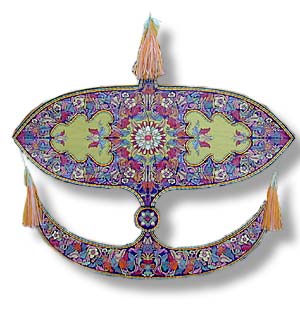 |
|
|
Wau bulan
Moon Kite
|
|
|
|
|
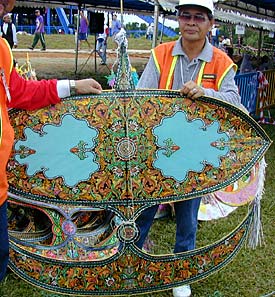 |
|
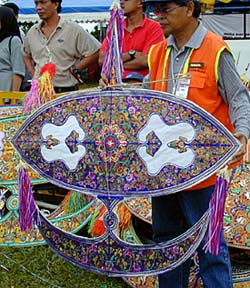 |
|
|
|
|
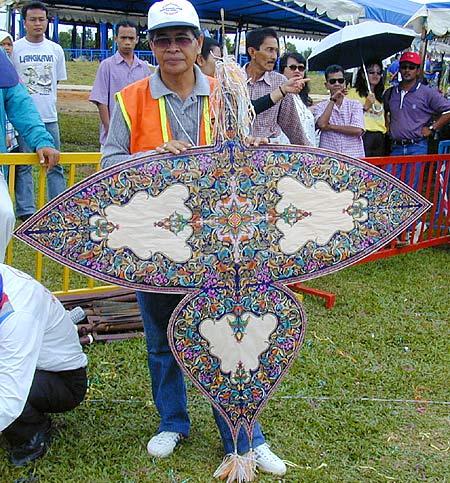 |
|
|
Wau jala budi
Woman Kite
|
|
|
|
|
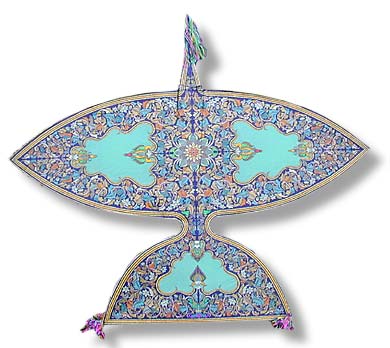 |
|
|
|
Wau kuching
Cat Kite
|
|
|
 |
 |
|
|
|
|
Wau merak
Peacock Kite
|
|
|
|
|
All
of these kites, except the Wau barat, are made by gluing cut out layers
on top of each other. It is almost a reverse appliqué method. Designs
are traced onto the paper, the paper is carefully cut out with a sharp
knife, then the cutout sections are pasted. By using different colors of
shiny foil paper, the patterns emerge. The Wau barat kites, which
resemble a wider version of the Wau bulan are only painted rather than
layers of glued paper. Since the Wau barat kites are painted, the design
work can be more creative and is less formalized by tradition. These
kites are able to fly in less wind and are named the early morning kite,
referring to the time of day when the wind is lightest. (Special thanks
here to David Wagner for helping with the information on the Malaysian
kites. He and Tal Streeter are completing a book about the Malaysian
kites, so look forward to seeing this book soon).
Judging starts with the Wau bulan category first, and the kites are
judged to be A, B or C on the shape and overall craftsmanship of the
kite. Better kites have the back more opaque so you cannot see the
detail of the cutout design work from the back.
The judges go through each category several times, often reevaluating
specific kites once the A, B or C group has been judged. The kites are
scored on a 1-20 basis, with the A category naturally having the higher
scores. The top ones of the art and construction judging are then judged
on the basis of their ability to fly and their hummers.
Wau kites must follow a traditional style of artwork in which a vine
comes out of a vase at the base or tail of the kite.
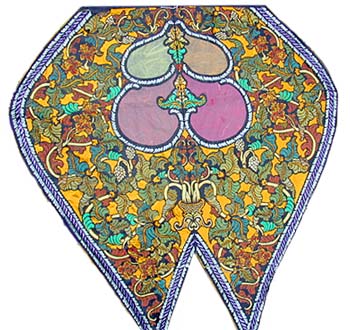 The
pattern must include leaves and flowers. The vine signifies the course
of a man's life and the flowers are the women. When the flowers are in
bud form, it symbolizes a young woman. The judge told us that nowadays
the kite makers often picture the flowers from the front, which is
simpler and easier to draw. He thought it was analogous to the fact that
woman today were more direct and looked you in the face. In the older
kites, flowers were drawn from the side and back, representing the shy
and more reserved way women acted in earlier times. How the leaves are
shaded is a considered too, showing how the leaves turn in the wind. On
better kites, there are two or more tones in the coloration. The
pattern must include leaves and flowers. The vine signifies the course
of a man's life and the flowers are the women. When the flowers are in
bud form, it symbolizes a young woman. The judge told us that nowadays
the kite makers often picture the flowers from the front, which is
simpler and easier to draw. He thought it was analogous to the fact that
woman today were more direct and looked you in the face. In the older
kites, flowers were drawn from the side and back, representing the shy
and more reserved way women acted in earlier times. How the leaves are
shaded is a considered too, showing how the leaves turn in the wind. On
better kites, there are two or more tones in the coloration.
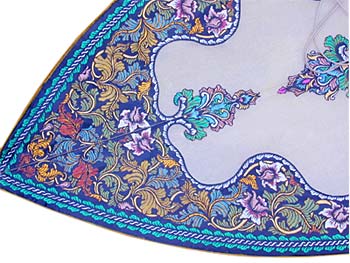
The more meandering the vine is drawn, representing
the twists and turns of life, the more interesting is the person's life.
In the center of the kite is a large central flower, called the ibu or
mother of all life, which looks like a mandala and is a required element
in the traditional design.
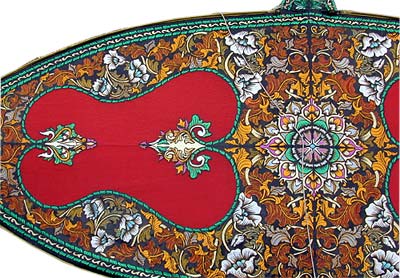
|
|
|
|
|
The
connection to the vine is hidden and the flower is often a complex
geometric design. The wings of the kites have an open area and inset in
this area are designs of a more expressionist nature. More freedom is
permitted in the design of this area than elsewhere in the kite.
The choice of colors is very important. If the colors clash or are more
contrasting, the kite is considered not as good quality. A better
quality kite has harmonious colors, representing the inner state of the
kite maker. If the kite is colored with bright reds and contrasting
blues, then it means the kite maker might be quick to anger and more
emotional. A kite with shades of blues and purples, or colors in soft
harmony, indicates a kite maker with a more peaceful nature.
|
|
|
|
Kite makers demonstrating the construction of traditional Wau
kites
|
|
|
|
|
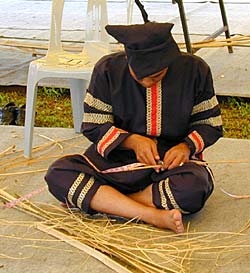 |
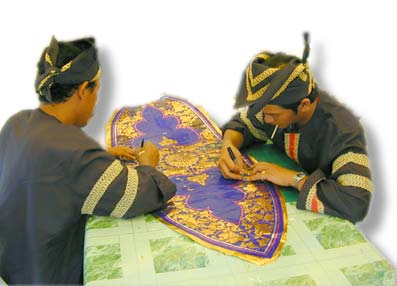 |
|
|
|
|
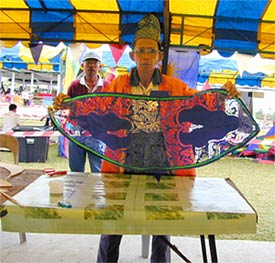 |
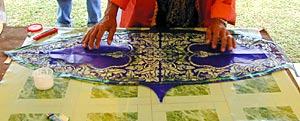 |
|
|
|
|
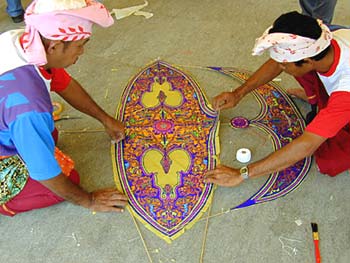 |
|
|
|
|
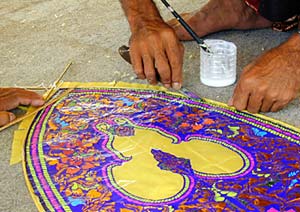 |
|
|
|
|
David Wagner's notes on the 1999 competiton
Sail graphics
- The border motif is called ‘larat’
- The center flower is called ‘ibu’(mother)
all life, represented here by numerous vines and flowers
originate out of sight, behind ibu, because origin of life
is mysterious and unknown. Ibu generates wing vines, leaves,
flowers, etc.
- The image at base of kites is the ‘flower
pot’ from which vines for the tail area originate (kuching,
bulan)
- The vines must follow from each other
properly and connect logically – they cannot begin
independently
- The vines are usually referred to as ‘twisting
dragons’.
- Various other border motifs are referred to
as ‘shark teeth’, ‘duck walk’ (referring to the
outspread tracks of a duck)
- The flowers on the sail never face toward
the viewer. They are always sideways, or oblique. It is
considered rude for the flowers to be shown from the front
- The form of the leaves is meant to suggest
leaves twisting in the wind, so they are often turned or
distorted.
Wau barat
- The Wau barat are always painted – as
opposed to paper applique of other kites.
- The Wau barat is the only Wau that has no
hummer
- The Wau barat is often made using batik
techniques; in fact, are usually painted by batik artists,
not kite makers
- Much more change is taking place with the
barat design, often they are unique and original designs (only
in the last 6 years) which are being gradually accepted in
competition. It should be understood that this is mostly
because these sails are painted by artists from other
disciplines.
Wau merak
- The merak has a completely different leaf
and flower design from other wau kites. It is more
Indonesian than Malaysian, and reflects the supposed origin
of the design
- It also has a head and tail, two of the
reasons it is not readily accepted in official Pelayang
competition (with the notable exception of events held in
Johor)
- The tail is usually heavy colored yarn, and
the head is wire or bamboo wrapped with the same yarn.
Judging
Judges are trained by the Majlis Pelayang
Malaysia, a state funded and regulated body. These judges are
awarded certificates of achievement, and regularly attend
seminars. There are different levels of judges for different
aspects of the judging process. Those judging the artistic
quality of the kites are often art teachers, or batik designers.
Flight judges are usually former or current kitemakers.
Materials
Usually independently bought, but often the
same, as paper sources are few in Malaysia. The humming strips
or ‘busurs’ can be ribbon or magnetic tape (which many
flyers prefer for casual flying) but for competition, they must
be a rattan strip
The best bamboo for wau kite frames is considered to be ‘buyoh’
or ‘duri’. It is cut during November or December for use 10
months later. The bamboo is treated in a number of different
ways. Typically, it is soaked in water, then heated to
straighten and toughen. This is often accomplished by wiring it
into the center of a steel pipe which is heated in a diesel oil
and wood fire.
Wau kites were originally said to be developed by wood carvers
who developed the layered paper technique. Malay wood carvings
greatly influenced the design
The original Waus were flown with very large hummers, and flown
over the rice paddies all night long during the windy planting
season. The rice farmer often stayed in a little shack for days
at a time in the center of his paddies, and had a lot of free
time for making kites. The villagers and farmers could hear the
humming sound in the dark – when it moved, they could track
the changes in the wind direction, and it was a very relaxing
and soothing sound at night.
Competition
- Scheduling of different classes is often
instantly modified to suit daily winds
- All lines are carefully measured at 150
meters long. Everyone uses monofilament fisihing line for
flying because it is cheap, readily available and has low
wind drag.
- A competition flight lasts for 10 minutes,
which is carefully timed. Years ago, (and still in some
outer kampongs) the flight was measured by the time it took
a half coconut shell with a small hole to sink in a bucket
of water.
- Four main flight measurements:
- a good launch
- a shallow figure eight flight
pattern
- a high angle of flight
- the sound of the hummer
- The angle of flight is an important measure
of flight performance, and is only measured once, at the
time of it’s highest level. 90 degrees is not uncommon
with very well built kites and ideal wind
- The hummer sound is usually quickly
ascertained during the launch – and is not a high point
item
- The flyer is allowed to handle the line for
the first minute of the flight. After that it is tied to the
measuring device and cannot be touched, unless the kite is
in trouble, such as coming down and requiring relaunch, or
gets tangled with other kites. The judges are usually
tolerant about this. The line can not be touched to raise
the kite's flying angle.
- Typically most team members gather around
the line, near the judge, to loudly exhort the kite to
higher altitude. This can be very entertaining to witness,
especially when 8 to 10 kite teams are working at once
It is important to note that Wau kites are
almost never built by a single individual, but by a group of
people. A Wau club will usually have one or two people (almost
always men, with the notable exception of one club in Langkawi,
dominated by a woman designer) who are very good at building
frames, one that does most of the sail designs, etc.
The prize money for these events is a significant reason many
builders are involved in the sport.
Occasionally, some older men do build an entire kite themselves.
It is rare, and they are usually not as high a quality in terms
of sail design complexity as the club built kites.
|
|
|
|
|
|
|
|
|